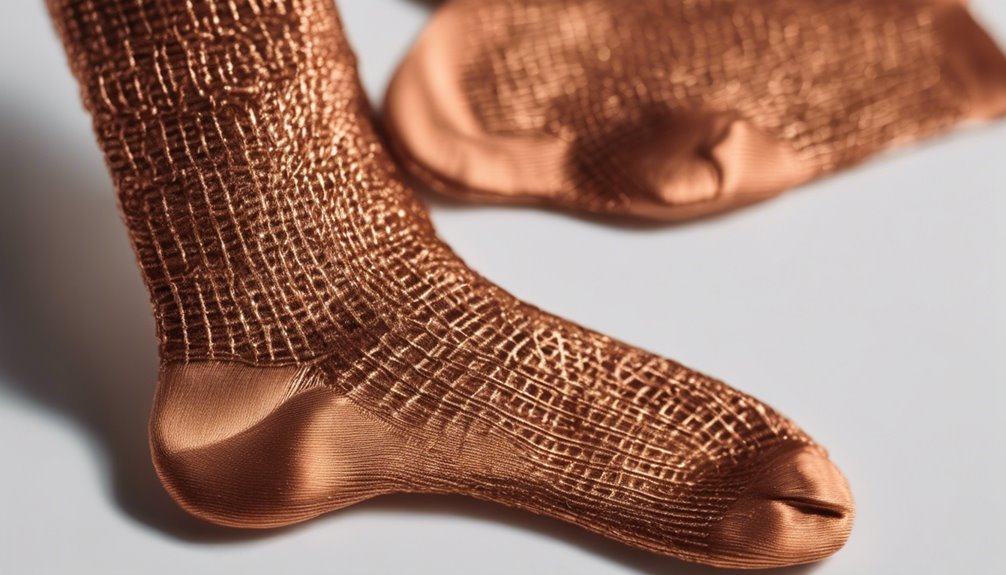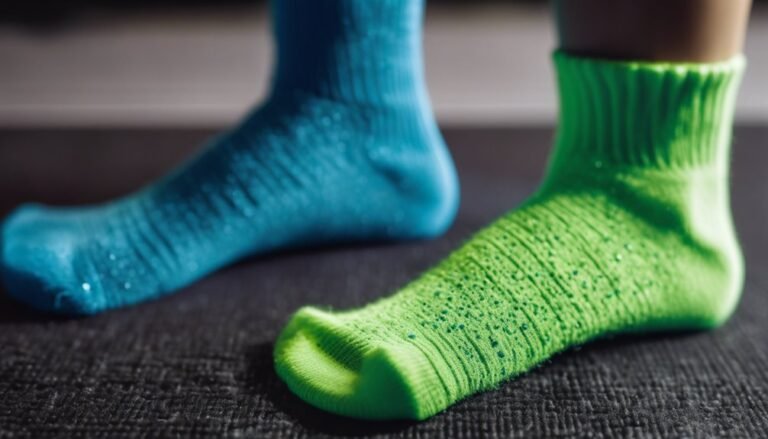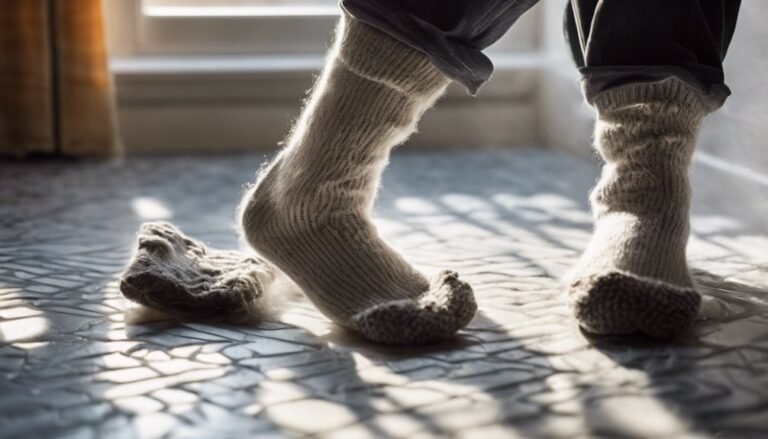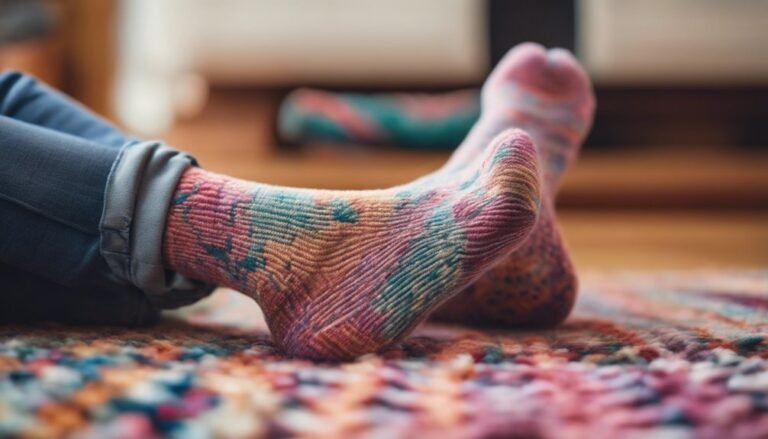Do Copper-Infused Socks Really Kill Bacteria & Prevent Infections?
Have you ever noticed how some socks seem to stay fresher for longer, even after a long day on your feet? Copper-infused socks are designed to do just that by effectively killing bacteria and reducing the risk of infections.
By integrating copper ions into the fabric fibers, these socks create a hostile environment for microbes. These ions disrupt microbial cell membranes, induce oxidative stress, and degrade nucleic acids.
Backed by scientific studies, copper's antimicrobial properties target a broad spectrum of bacteria, fungi, and viruses.
Beyond infection prevention, these socks offer odor control and thermal regulation.
Discover the fascinating benefits and effectiveness of copper-infused socks for yourself.
Understanding the Antimicrobial Properties of Copper
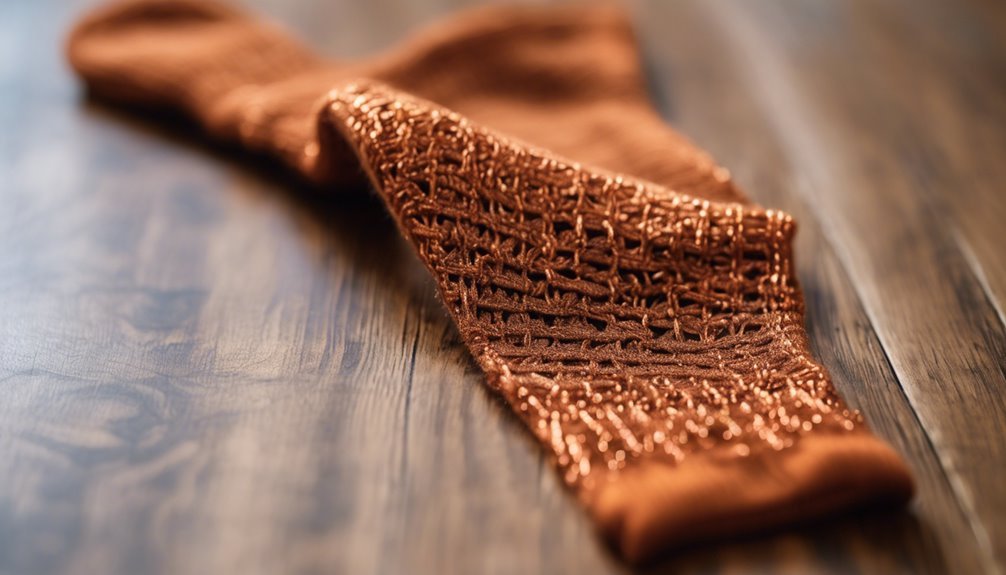
When delving into the antimicrobial properties of copper, it is essential to understand that this metal exhibits a unique ability to disrupt and neutralize pathogenic microorganisms. Copper ions play a significant role in these antimicrobial mechanisms. They interact with microbial cell membranes, causing structural damage and ultimately leading to cell death. By penetrating the cell wall, copper ions induce oxidative stress, disrupting fundamental cellular processes. This results in the denaturation of proteins and degradation of nucleic acids, effectively neutralizing the threat. You'll find that copper's ability to inactivate a broad spectrum of bacteria, fungi, and viruses stems from these multifactorial actions. For those seeking autonomy from pathogens, embracing copper's innate antimicrobial prowess provides a scientifically-backed avenue for enhancing personal hygiene and reducing infection risks.
The Science Behind Copper-Infused Textiles
As you explore the science behind copper-infused textiles, you'll discover that their effectiveness hinges on the strategic integration of copper ions into fabric fibers. This innovation draws on copper's rich history as a potent antimicrobial agent, dating back to ancient civilizations. Modern textile innovation utilizes advanced techniques to embed copper ions, ensuring they remain active over time. Copper ions disrupt bacterial cell membranes, causing a cascade of cellular reactions that ultimately lead to bacterial death. Through meticulous engineering, textiles maintain breathability and comfort while enhancing antimicrobial properties. The freedom to move without fear of infection or odor stems from this precise science. By leveraging copper's time-tested efficacy, these textiles represent a leap forward in both personal hygiene and fabric technology.
How Copper-Infused Socks Are Made
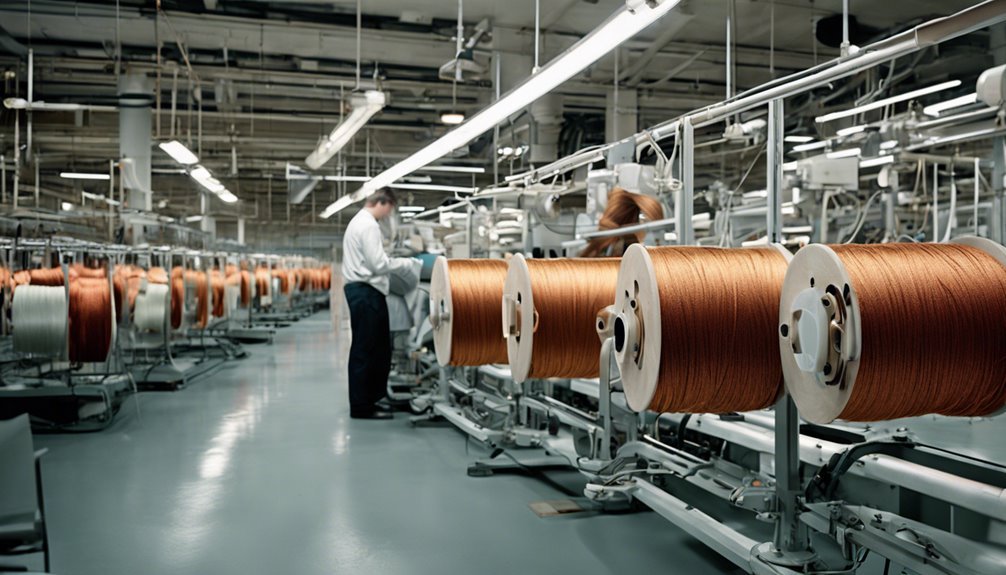
To produce copper-infused socks, manufacturers begin by integrating copper ions directly into the yarn used for knitting. This process starts with copper sourcing, where high-purity copper is selected to guarantee quality and effectiveness. The copper is transformed into fine particles and then embedded into the fibers during the spinning stage. By doing so, the material retains the metal's antimicrobial properties without compromising fabric comfort.
The manufacturing processes involve advanced techniques like ion-binding and encapsulation, guaranteeing that the copper particles are uniformly distributed and securely bonded to the fibers. This meticulous method preserves the socks' durability and function, offering freedom from bacteria-related concerns. As the yarn is woven into socks, the embedded copper works tirelessly, enhancing the fabric's inherent protective features.
Examining the Claims: Do They Really Kill Bacteria?
When you're evaluating the antimicrobial claims of copper-infused socks, it's essential to take into account the well-documented antimicrobial properties of copper. Scientific studies have shown that copper ions disrupt bacterial cell membranes and interfere with their metabolic processes, leading to bacterial death. However, you'll need to scrutinize the specific evidence regarding copper's efficacy in textile applications, as laboratory conditions may not fully replicate real-world sock usage.
Antimicrobial Properties of Copper
Although the ancient use of copper for its medicinal properties is well-documented, modern science is now rigorously examining whether copper-infused materials like socks genuinely kill bacteria. Copper history reveals its applications in wound healing and sterilization. Today, you find copper embedded in fabrics, promising antimicrobial action. Copper ions are hypothesized to disrupt bacterial cell membranes, leading to cell death. This mechanism suggests potential in mitigating bacterial infections. However, evaluating its real-world efficacy requires understanding the precise conditions under which copper acts.
Consider these points:
- Copper's effectiveness can vary based on the concentration of ions.
- The longevity of the antimicrobial effect is still under investigation.
- Copper applications extend beyond textiles, including medical devices.
- Understanding environmental factors is essential for best performance.
Explore this freedom with informed choices.
Scientific Evidence and Studies
Emerging research on copper-infused socks presents a fascinating intersection of ancient wisdom and contemporary science. Studies indicate that copper's antimicrobial properties can indeed reduce bacterial presence, suggesting potential benefits for sock hygiene. Clinical trials reveal that copper oxide fibers in socks have a measurable impact on reducing odor-causing bacteria. However, the effectiveness varies across different studies, warranting further investigation.
It's important to take into account copper toxicity, although the risk appears minimal in consumer products. Existing research supports copper's role in mitigating bacterial infections, but long-term effects remain under-explored. For those seeking freedom from conventional solutions, copper-infused socks offer a promising alternative. Yet, one must balance enthusiasm with scientific skepticism, ensuring that claims of superior sock hygiene are backed by rigorous evidence.
Benefits Beyond Bacteria: Odor Control and More
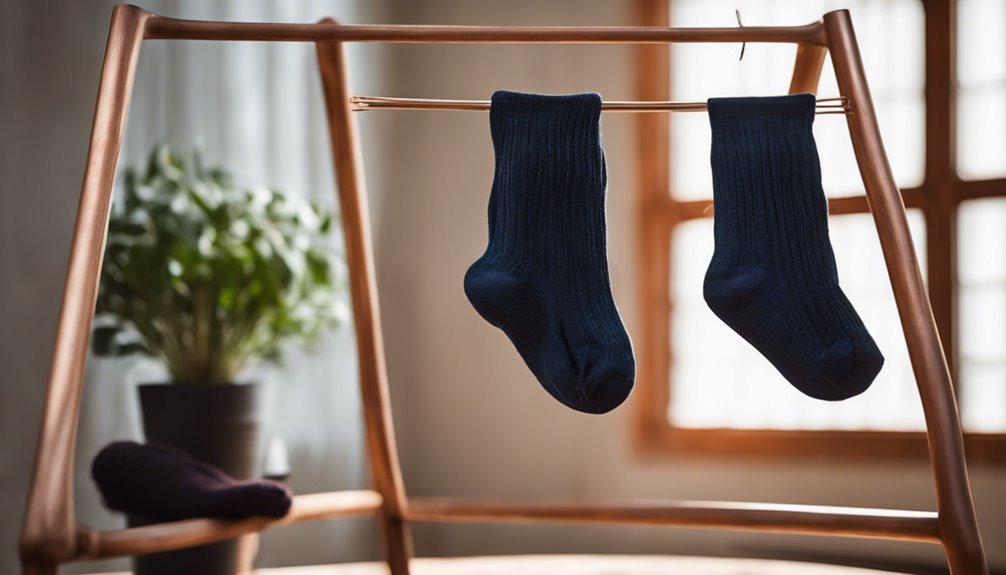
As you explore the multifaceted advantages of copper-infused socks, you'll discover that their benefits extend well beyond just bactericidal properties. One of the key advantages is effective odor reduction. Copper ions naturally combat odor-causing microbes, ensuring your feet remain fresh. Additionally, superior moisture management is achieved as copper fibers wick away sweat, reducing the damp environment where bacteria thrive. This translates to enhanced comfort and hygiene. The inclusion of copper can also bolster thermal regulation, providing a balanced foot temperature.
- Odor Reduction: Copper ions neutralize odor-causing microbes.
- Moisture Management: Advanced sweat-wicking properties keep feet dry.
- Thermal Regulation: Copper fibers help maintain ideal foot temperature.
- Durability: Enhanced fabric longevity due to copper's robust nature.
These benefits offer a liberating experience for those seeking enhanced comfort and hygiene.
Expert Opinions on Copper-Infused Socks
Copper-infused socks offer a range of benefits, but it's important to contemplate what experts in the field have to say about their effectiveness. Expert insights reveal that copper's antimicrobial properties can indeed contribute to bacterial reduction on the skin. However, the health implications of wearing these socks extend beyond mere bacterial control. Dermatologists highlight the potential for copper to reduce fungal infections, enhancing foot hygiene. Clinical studies corroborate these claims, with evidence suggesting a decrease in microbial colonies on copper-treated fabrics. Yet, not all experts agree on the extent of these effects, emphasizing the need for further research. For those seeking freedom from foot infections, copper-infused socks present a promising option, albeit one that should be approached with informed caution.
Comparing Copper-Infused Socks to Other Antimicrobial Options
While copper-infused socks are gaining popularity, it is essential to compare them to other antimicrobial options to make an informed choice. You may encounter copper alternatives such as silver-infused textiles, known for their broad-spectrum antimicrobial efficacy. Synthetic options, like polyester treated with antimicrobial agents, offer a different approach, leveraging chemical coatings for bacterial inhibition. Additionally, you might consider bamboo-based fibers, which naturally resist bacterial growth due to their moisture-wicking properties. Each option presents distinct benefits and limitations:
- Silver-Infused Textiles: Effective but may cause skin irritation in sensitive individuals.
- Synthetic Polyester: Cost-effective but may lose efficacy after washing.
- Bamboo Fibers: Eco-friendly but less effective than metals.
- Copper-Infused Socks: Durable and effective but typically higher in cost.
Considerations for Choosing Copper-Infused Socks
When choosing copper-infused socks, you'll want to prioritize material composition, as the copper integration's efficacy can vary considerably based on the manufacturing process, which impacts the antimicrobial properties. Comfort and fit are equally critical; socks with inadequate elasticity or poor design can hinder circulation and undermine the intended benefits. Additionally, focus on durability and longevity, since high-quality socks should withstand regular wear and laundering while maintaining their functional integrity.
Material Composition Matters
Understanding the intricacies of material composition is essential for selecting the right copper-infused socks. You'll want to take into account how material sourcing and manufacturing processes impact the efficacy and durability of these socks. High-quality copper-infused socks often combine copper fibers with materials like cotton or polyester, enhancing antimicrobial properties. When evaluating options, focus on:
- Copper Content: Verify the percentage of copper, as higher content typically means better antimicrobial action.
- Material Blend: Reflect on how the blend affects breathability and moisture-wicking capabilities.
- Durability: Assess manufacturing processes to guarantee the socks withstand regular wear and washing without losing functionality.
- Eco-Friendliness: Check for sustainable material sourcing, reflecting a commitment to environmental responsibility.
Comfort and Fit
Considering the comfort and fit of copper-infused socks is essential, as these factors directly influence their effectiveness and your overall satisfaction. A proper fit guarantees ideal contact with the skin, enhancing the antimicrobial properties. Prioritize socks designed with breathable fabric, as this promotes moisture wicking and temperature regulation, critical in reducing bacterial growth. Breathability facilitates airflow, preventing dampness that can lead to infections. Additionally, focus on cushioning support, which provides enhanced comfort during physical activities. This support not only alleviates pressure but also contributes to foot stability. Evaluate the sock's elasticity to guarantee a snug fit without constriction, allowing freedom of movement. A well-engineered combination of these elements guarantees the socks perform as intended, offering both protection and comfort.
Durability and Longevity
In addition to comfort and fit, the durability and longevity of copper-infused socks greatly dictate their value and efficacy. Understanding wear and tear dynamics is essential when evaluating their lifespan expectations. Copper-infused fibers are engineered to resist degradation, but performance varies by brand and material composition. You should consider:
- Material Strength: High-quality blends resist wear and tear, enhancing durability.
- Copper Infusion Rate: A higher concentration can improve longevity but may affect flexibility.
- Manufacturing Techniques: Advanced knitting methods can extend the lifespan by reinforcing high-stress areas.
- Care Instructions: Proper washing and drying can prevent premature wear, maximizing utility.
Frequently Asked Questions
How Long Do Copper-Infused Socks Typically Last Before Losing Effectiveness?
You're curious about copper-infused socks' longevity factors. Typically, their effectiveness duration spans several months, depending on use and care. Regular washing and wear may reduce efficacy over time, impacting antimicrobial properties but allowing freedom from frequent replacements.
Are There Any Side Effects of Wearing Copper-Infused Socks?
Wearing copper-infused socks might cause skin irritation if you're sensitive to the material. It's crucial to monitor for redness or itching, as these could indicate an adverse reaction. Always choose socks made from high-quality, breathable materials.
Can Copper-Infused Socks Be Worn by Individuals With Sensitive Skin?
If you've sensitive skin, copper-infused socks offer benefits, like antimicrobial properties. Yet, be cautious of copper allergy concerns. Evidence suggests minimal risk, but a patch test guarantees freedom from adverse reactions while enjoying enhanced comfort and hygiene.
Do Copper-Infused Socks Require Special Washing Instructions?
Imagine your socks dancing in a gentle breeze of cleanliness. With copper-infused socks, opt for cold water and mild detergent when washing. Avoid bleach and fabric softeners. These maintenance tips guarantee longevity and freedom from wear and tear.
Are Copper-Infused Socks Safe for People With Metal Allergies?
If you've a metal allergy, copper-infused sock materials might trigger reactions. Patch testing's advisable to ascertain safety. While copper's antimicrobial, its presence in socks should be minimal, but always prioritize your comfort and health over potential benefits.

